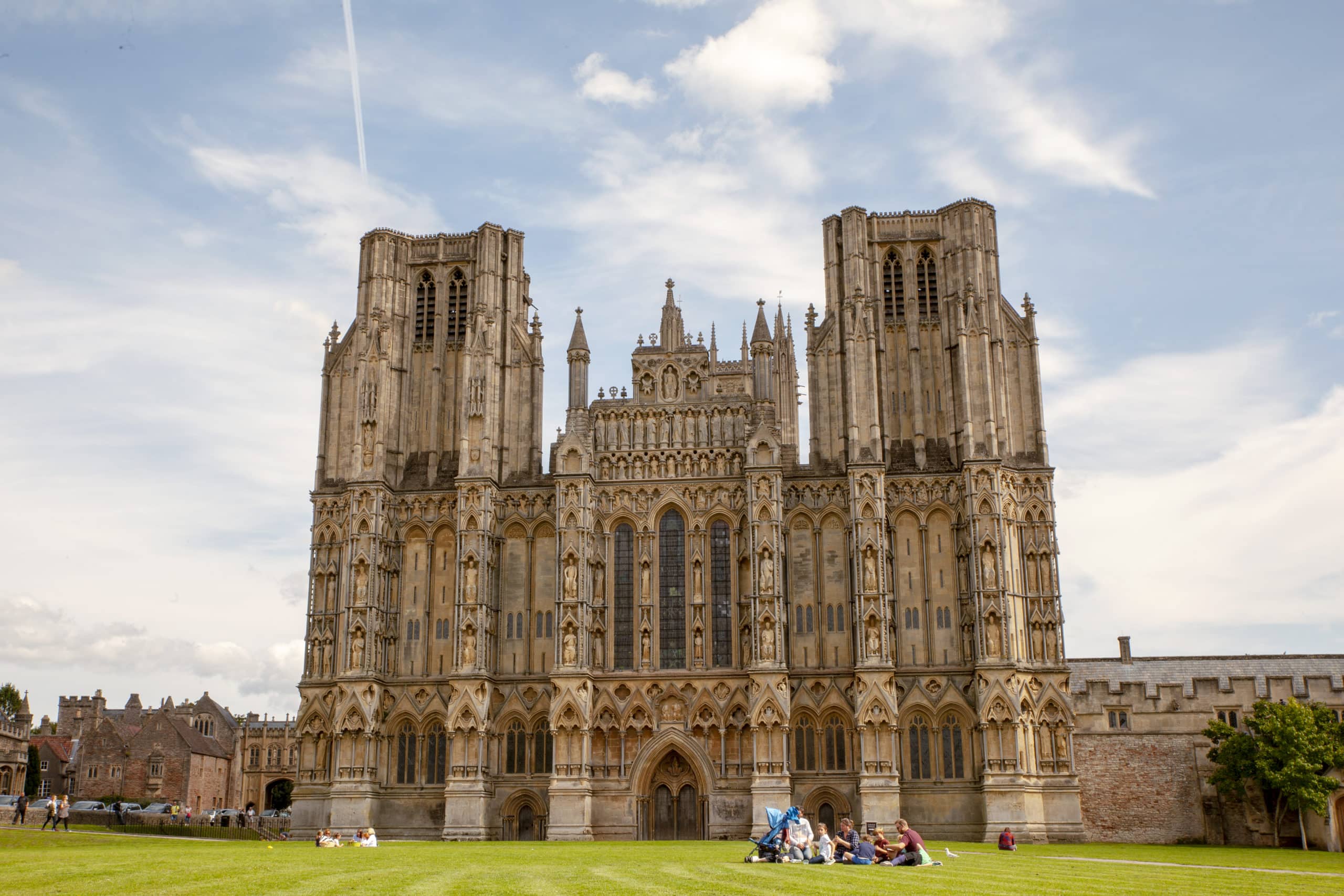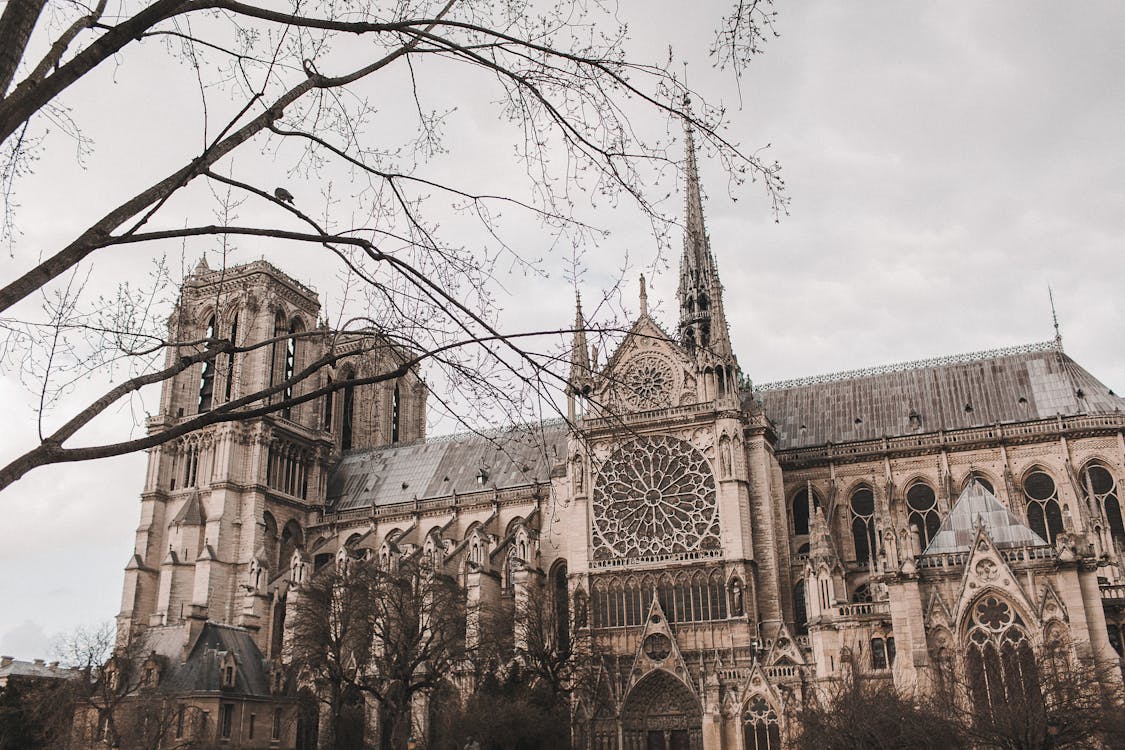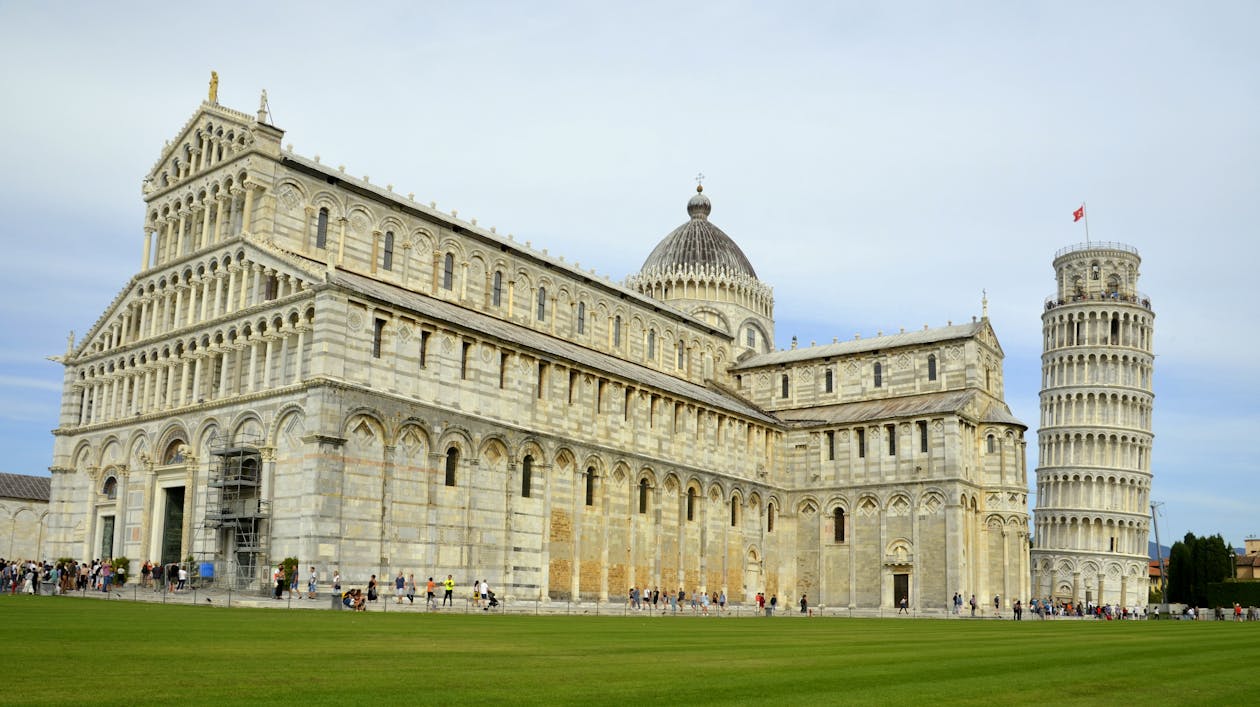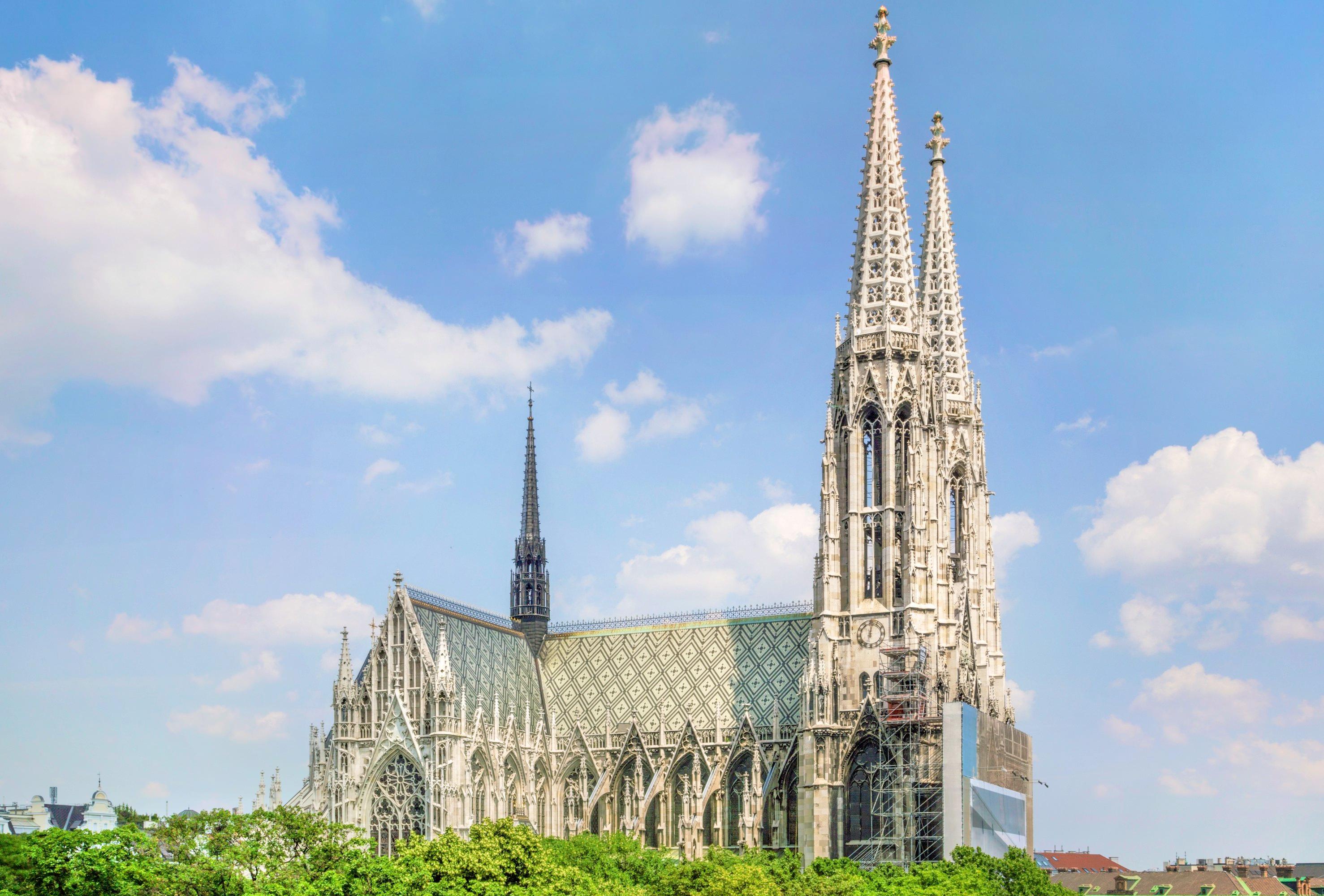Imagine walking through the cobbled streets of a medieval town, surrounded by towering stone structures that have stood the test of time. Their intricate designs tell the story of a time long gone, yet the influence of the architecture can still be seen all around us. This article delves into medieval architecture to understand its rich and fascinating history and highlight notable examples.
What Is Medieval Architecture?

Image Credits: englishhistory.net
Medieval architecture developed in Europe from the 5th to the 15th centuries during the Middle Ages. The style of architecture was influenced by cultural and religious beliefs of the time and practical considerations such as the need for protection and the desire to display wealth and power.
It is characterized by the use of stone and brick, the development of ribbed vaults, and the use of rounded and pointed arches. The style is also known for beautiful elements such as large stained glass windows, elaborate sculptures, and intricate carvings.
Medieval architecture encompasses a range of styles, including Byzantine, Romanesque, and Gothic architecture. Here is a chronological overview of how this architecture developed and evolved through the centuries:
I. Through Byzantine Architecture

Image Credits: smarthistory.org
Byzantine architecture was popular during the Byzantine empire, centered in Constantinople (modern-day Istanbul), and lasted several centuries.
During that time, architects were interested in grand domes, intricate mosaics, and ornate decorative elements, which today are hallmarks of the medieval period. In addition, the era was marked by arches, the interplay of light and shadow in buildings, and the use of rich materials such as marble, gold, and glass.
These elements helped to establish the style as a symbol of wealth, power, and cultural sophistication, and they had a lasting impact on the development of medieval architecture.
II. Through Romanesque Architecture

Image Credits: 2travellingacrosstime.com
Romanesque architecture, which was somehow based on Roman architecture, emerged in the 10th century and was another key contributor to the evolution of medieval architecture. It was characterized by rounded arches, barrel vaults, and classical elements, such as columns, arcaded walls, and pilasters, which created a simple, functional, and sturdy structure for buildings such as churches, monasteries, and castles.
Romanesque architecture introduced the use of barrel vaults, leading to larger interior spaces, and also made important contributions to the decorative arts through carved portals, capitals, and tympana.
III. Through Norman Architecture

Image Credits: britannica.com
Norman architecture emerged in the 11th century after the Norman conquest of England in 1066. It was heavily influenced by Romanesque architecture, which had started to develop in Italy and France in the preceding centuries.
Norman architecture was known for using the semi-pointed arch and rounded or cylindrical pillars. The arch allowed for higher, more elaborate vaults, one of the key innovations that helped propel the development of the pointed arch in the Gothic style.
IV. Through Gothic Architecture

Image Credits: architecturaldigest.com
Gothic architecture appeared in the 12th century and was known for using pointed arches, ribbed vaults, and flying buttresses. These created a lighter and airier look, while the intricate stone and glasswork added a sense of beauty and awe to the structures.
Gothic architecture featured decorative arts like intricate sculptures, medieval stained glass, and illuminated manuscripts. The style symbolized the power and wealth of the church; the grand cathedrals, abbeys, and other religious structures of the time were often seen as symbols of the church’s power, and the style was used to promote its influence and spread its teachings.
Top Characteristics of Medieval Architecture

Image Credits: southforkcaravans.co.uk
As you can see above, medieval architecture was influenced by styles from Byzantine to Gothic architecture, thus making it the most influential type of architecture in the world. If you want to know what makes medieval buildings, here are the characteristics to look out for:
a) Heavy Use of Stone and Masonry

Image Credits: pikist.com
One of the best defining characteristics of medieval architecture is the use of heavy stone blocks and masonry. Architects used stone across medieval Europe to give each building a solid and durable appearance.
Medieval architects also used stone and masonry to create intricate and ornate designs. Sculpted stone capitals, columns, and other decorative elements created a sense of grandeur and impressiveness within buildings. Additionally, the architects used different stone colors and textures for visual interest to enhance the overall aesthetic of the building.
Stone and masonry were also functional medieval architecture. The stone walls were used to provide protection, both from the elements and invading forces, while masonry was used for constructing fortifications, such as castle walls, towers, and gates, for improved security.
b) Arches

Image Credits: twitter.com
Pointed arches were one of the defining characteristics of medieval Gothic architecture. These arches replaced the semi-circular and round arches commonly used in earlier Norman and Roman architecture. The new pointed arches allowed for greater height, spacious interiors, and artistic expression.
These arches were formed by two curves that converged at a point rather than the single curve of a rounded arch, thus allowing for greater height and thinner walls and creating a more intricate and decorative design. The medieval arches were mostly used in doorways, windows, and the ribbed vaults of ceilings.
c) Vaults

Image Credits: seeingthepast.com
Medieval architecture featured various vaulting styles, including:
-
- The barrel vault consists of a continuous arch running the length of the space.
-
- The groin vault is created by the intersection of two barrel vaults at right angles. It creates a unique cross-shape in the ceiling.
-
- The rib vault is a more complex form of vaulting that uses ribs or arches to support a series of intersecting arches. The ribs give the structure additional strength and stability.
-
- The fan vault is highly decorative and is characterized by fan-shaped curves in the ribs and arches. This type of vaulting was often used in Gothic architecture and is considered a hallmark of the style.
d) Flying Buttresses
:max_bytes(150000):strip_icc()/1626px-Flying_buttresses_of_Notre-Dame_de_Strasbourg-31d8dcc2ca5144b3943657d43a3e6a53.jpg)
Image Credits: thoughtco.com
Flying buttresses were a series of arched supports that counteracted the thrust of vaults. They gained momentum during the latter medieval styles, especially in Gothic churches.
They were attached to outside walls and allowed the roof’s weight to transfer to the ground rather than the walls. This allowed for greater height and larger stained glass windows, which let in more light and created a luminous and otherworldly atmosphere.
e) Intricate Decorations

Image Credits: odessytraveller.com
Medieval buildings were characterized by their rich and intricate decoration. In medieval church architecture, these decorations reflected religious and cultural values to create awe and reverence in visitors. Decoration included intricate carvings, sculptures, and moldings used to depict religious figures and scenes. The intricate details and symbolism of these carvings reinforced the religious message of the building.
In addition, stained glass windows were a mainstay in all architectural styles of medieval Europe. These windows created luminous and colorful interiors, which helped define the mood and purpose of the buildings. Other types of medieval buildings featured detailed carvings, sculptures, and gargoyles to improve the aesthetic appeal.
Examples of Medieval Architecture
Judging by the characteristics above, medieval buildings were built to last and communicate the significant bygone era. The buildings that survive are mostly church, military, and castle architecture. So, from medieval religious architecture to medieval secular architecture, here are some examples you can visit.
1. Westminster Abbey, London, England
Image Credits: timeout.com
Westminster Abbey is a historic Gothic or French-style church in London, England. It was built in the 11th century by King Edward the Confessor and consecrated in 1065. The famous church has been the site of the coronation of every English monarch since William the Conqueror in 1066.
One of the most notable medieval architectural elements is the pointed arches, found throughout the building and characteristic of Gothic architecture. In addition, the intricate stone carvings and sculptures show the skill and craftsmanship of medieval masons.
Westminster Abbey also features ribbed vaults and flying buttresses that increase the stability and strength of the building, not to mention beautiful stained glass windows, which are examples of the medieval Gothic architectural style.
2. Notre-Dame de Paris, Paris, France

Image Credits: pexels.com
Notre Dame de Paris, located in the heart of Paris, France, is an iconic medieval cathedral from the 12th and 13th centuries. It is one of the most well-known examples of French Gothic architecture. The cathedral has elaborate flying buttresses supporting its walls and accentuating its impressive height. It is also known for its pointed arches, a hallmark of Gothic architecture seen throughout the building.
One of the most famous medieval Romanesque churches, Notre Dame, sports stained glass windows. At the same time, the interior is adorned with elaborate sculptures, carvings, and artwork that depict the architecture of the Middle Ages. While the cathedral fell victim to a fire in 2019, ongoing restoration works aim to restore it to its former glory and architecture.
3. Basilica of Saint-Denis, Paris, France

Image Credits: franciaturismo.com
The Basilica of Saint-Denis, Paris, France, was built in the 12th century and is considered the birthplace of Gothic architecture. The basilica was also a significant center of religious and political power, and it was here that the kings of France were buried for centuries.
The most notable features of the Basilica of Saint-Denis are its arches, ribbed vaults, and elaborate stained glass windows that are reminiscent of the medieval period. In addition, the basilica features extensive use of sculptures and carvings, and its façade and interior are adorned with intricate sculptures which depict biblical scenes and historical events.
4. The Leaning Tower of Pisa: Pisa, Italy

Image Credits: pexels.com
The Leaning Tower of Pisa is a majestic medieval architectural marvel in Pisa, Italy. Built in the 12th century as a bell tower for the nearby cathedral, it is known for its iconic lean caused by an unstable foundation.
Despite its uneven appearance, the tower was constructed with a strong, sturdy structure that is a testament to the skills of medieval architects. It is an example of Romanesque architecture, with its circular base, sturdy pillars, and blind arches. It is also notable for its intricate carvings and sculptures, which add to its unique beauty and character.
5. Salisbury Cathedral: Salisbury, England

The Salisbury Cathedral, located in the quaint town of Salisbury in England, is a stunning example of architecture in medieval England. It was built in the 13th century as one of England’s finest examples of early Gothic architecture.
The cathedral has a towering spire that rises over 400 feet into the sky and is the tallest in England. It also features pointed arches, ribbed vaults, and delicate stone tracery, which highlight the intricate design and attention to detail characteristic of Gothic architecture.
6. Krak des Chevaliers: Talkalakh District, Syria

Image Credits: wikipedia.org
Krak des Chevaliers is a medieval castle in the Talkalakh District of Syria, built in the 11th century by the Knights Hospitaller. It served as a major fortress during the Crusades, strategically located on a hilltop to offer a commanding view of the surrounding countryside.
One of the most impressive medieval features of the castle is its massive outer walls, which were built with a double layer of stone and reinforced with towers at regular intervals. Krak des Chevaliers is a prime example of Romanesque architecture, with its rounded arches and barrel-vaulted ceilings.
7. Vitus Cathedral, Prague, Czech Republic

Image Credits: thecreativeadventurer.com
St. Vitus Cathedral, located in Prague, Czech Republic, is a Gothic cathedral completed in 1929. Its grandiose structure is replete with ornate elements of medieval architecture, including the towering spires and stained-glass windows that are a testament to its historical significance.
It features an intricate network of ribbed vaults and flying buttresses, which improve its weightlessness and grace. The pointed arches and slender columns imbue the interior with a sense of height and grandeur, while the richly decorated portals and sculptures embellish its exterior. The structure’s overall effect is serenity, befitting a church dedicated to the patron saint of Bohemia.
8. Maria Laach Abbey: Andernach, Germany
Image Credits: eifel.info
Maria Laach Abbey, located in Andernach, Germany, was built in the Romanesque style in the 12th century. Its construction was commissioned by the powerful Counts of Laach, who sought to establish a religious center for the surrounding region.
The abbey is characterized by its rounded arches, sturdy pillars, and thick walls, which are hallmarks of the Romanesque style. These heavy, solid elements support the structure’s weight to withstand the forces of nature. In addition, its central nave is lined with towering columns and features a ribbed vaulted ceiling. This imposing space is illuminated by rows of clerestory windows, which let in ample light.
9. Sainte-Chapelle: Paris, France

Image Credits: thetrainline.com
Sainte-Chapelle is a stunning medieval church in the heart of Paris, France. Commissioned by King Louis IX in the mid-13th century, it is a testament to the grandeur and luxury of the French monarchy during the Middle Ages.
The church boasts intricate architectural elements like stained glass windows that span nearly the entire height of the chapel, flooding the interior with radiant light for an ethereal atmosphere. Its ribbed vaults, flying buttresses, and delicate stonework create a breathtaking display of medieval engineering and artistry.
10. Stephen’s Cathedral, Vienna, Austria

Image Credits: trip.com
St. Stephen’s Cathedral, Vienna, Austria, has stood tall for over 700 years and continues to captivate visitors with its ornate design and rich history. Constructed in the late 12th century, it showcases the distinctive style of Gothic architecture, characterized by its towering spires and intricate stone carvings.
The cathedral’s façade is adorned with statues of saints and biblical figures, presenting a striking image that embodies the piety of the medieval era. The interior is equally awe-inspiring, with ribbed vaults reaching toward the sky and stained glass windows illuminating the nave with vibrant hues. Finally, the high altar also sports intricate carvings and golden adornments.
Conclusion
Medieval architecture is truly a marvel to behold!
From the towering spires of Gothic cathedrals to the intricate stone carvings of Romanesque abbeys, the Middle Ages left behind a legacy of beauty and innovation that continues to awe and inspire. So, as you wander through the ancient streets of Europe, taking in the sights and sounds of centuries past, there’s no denying the impact that Medieval architecture has had on our world today.
















